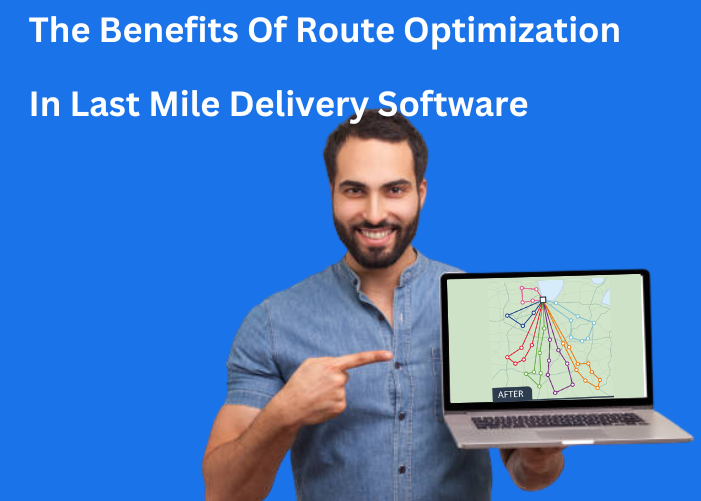1) What benefits does route optimization in last-mile delivery software bring?
We live in the Technological Era. All aspects of life, from the moment we wake up till we retire for the night, are impacted – dictated? – by technology!
Therefore, it should hardly be a surprise that in an area that is complex, vast, and operates at a frenetic global scale across 24*7, technology has reached levels that were hitherto unimaginable. Namely, the Logistics and Distribution Industry.
We track our Uber driver approach our pickup spot, track our Amazon package as it goes through the miles, track our food delivery as it nears, and track our medicines as it arrives closer via, well, a drone! The list is endless, and none of it would have been possible without modern technology. And, importantly, the technology deployed across the last mile of delivery.
Defining Last-Mile Delivery
In the world of Logistics, Distribution & Shipping, last-mile delivery is the last leg of delivery wherein a package leaves a warehouse for the final delivery to the end customer.
For example, it is the route that a delivery truck takes from an Amazon Fulfillment Center to its end-customer’s door.
It is the most complex, expensive, challenging, and resource-intensive phase of the entire delivery cycle!
2) Top benefits of route-optimization in last-mile delivery software?
Let us look at some leading benefits of last-mile technology with regard to route optimization.
i) Improved visibility: A leading benefit of today’s last-mile delivery software is the visibility that it affords its users, right from supply-chain stakeholders that are logged in through to the end-user.
The modern consumer (e.g. Ecommerce consumer, online-food customer, parents of school-bus children, online grocery customer) demands to know where his parcel/vehicle is – when it is shipped, which distribution warehouse it has progressed to when it has reached its final warehouse when it is out for final-delivery i.e. the last-mile that ends at his doorstep. Or, even when it’s late.
Delivery software has provided this i.e. vastly improved visibility and end-to-end shipment tracking – the customer can track his package at all times. This provides your customer that all-important ‘peace of mind’! It also gives you some more leeway when it comes to late deliveries due to legitimate reasons (traffic congestion, weather, etc.).
Optimizing Delivery Operations
The first step to optimizing delivery operations is to set up goals for effective delivery and then investigating (and, implementing) methods to achieve those goals.
Also important is prioritizing orders based on importance and planning the delivery process accordingly.
Optimizing routes, planning delivery-drops, organizing fleet-vehicles and drivers are just some important steps toward achieving this.
Although not “purely quantified” in dollars, it isn’t difficult to imagine the various costs, as well as efficiency metrics that are vastly improved due to this single element. Customer service work hours, customers that might’ve gotten irate due to late deliveries without being informed, customer satisfaction due to a visible and connected final leg of delivery…well, the list of benefits is long.
ii) Lower operating cost (e.g. maintenance, fuel): Modern logistics strategies like micro-warehousing (for popular everyday items), urban warehousing, and a judicious mix of large and satellite warehouses (etc.) are key to shortening delivery times.
All this was mostly heralded by the “Amazon-ization” of the delivery model i.e. Same-day delivery, and 24-hr delivery. This necessitated that your inventory be stored as close to the end destination as possible.
While the benefits to the end customer are easily understood, managing such a complex network isn’t an easy task. However, the advent of modern delivery software, powered by its AI, ML, and robust algorithms allows such a complex operation to be efficiently managed. As a result, it cuts down on miles traveled, fuel consumed, maintenance required, emissions made, or even (total) resources consumed. Ultimately, this leads to lower operating costs, which contributes to overall business profitability.
Can Your Last-Mile Delivery Be Profitable?
Although last-mile delivery is the costliest part of the supply chain, companies could still make a notable profit by using proven strategies to tackle high-costs, while increasing efficiency at the same time.
ii) Quicker delivery: Regardless of all that you’re doing to “improve the logistics and delivery business” the end customer is only concerned with receiving his parcels quickly and at an acceptable delivery charge!
While it may seem like stating the obvious, shorter delivery times is the star benefit of route optimization, and it really cannot be stressed enough. It is, now, often the difference between a customer selecting one brand/company over the other i.e. the USP, or critical differentiator.
Top Challenges in Implementing Last-Mile Delivery.
- Expensive
- Complex logistics, frenetic pace of implementation
- Route-optimization & planning
- Managing the supply-chain
- Managing delivery-fleet (including drivers)
- Reverse logistics (for rejected, or failed deliveries)
iv) ePOD (electronic-proof-of-delivery): Building on the above point, another biggie in shortening delivery times is the electronic-proof-of-delivery.
Gone are the days when the courier would toss a parcel on your front porch and tag it as “delivered”! Now, carriers need concrete evidence of package delivery. Pictures, e-signature, and barcode scans are some typical ways that delivery software has enabled further shortening of the entire delivery process – remember, if it took painstakingly long to complete the paperwork after having reached your customer’s doorstep, it would still extend the process and likely dissatisfy – and annoy!- the customer.
v) Leveraging your existing network of stores and warehouses: Retailers that have an elaborate brick-and-mortar retail network, as well as warehouses to serve those retail outlets, are now using it as a clever combination.
As mentioned above, using micro-warehouses or urban warehouses is critical in shortening delivery times. Retailers are now also using some retail brick-and-mortar locations as fulfillment centers. This also includes using a retail store that is currently open for retail customers as a part warehouse for order fulfillment. This acts as a win: win since real estate space can be put to optimum use, thus improving the overall business ROI. The onset of the pandemic somewhat forced this strategy in a hurry, and it has grown, since.
For retailers that have retail locations in proximity to major customer areas, and are also available online, this is a particularly handy strategy. Should you so choose, you can order online, and pick it up in-store immediately instead of having to wait even a few hours. Necessity is the mother of invention, after all!
Conclusion: As is evident, the benefits of route optimization via the use of modern, automated, GPS-enabled last mile delivery software are many. Be sure to select one that suits your business needs.




